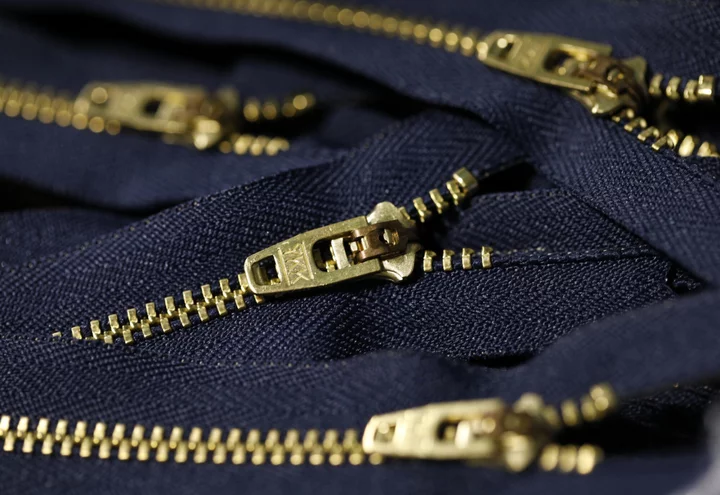A leading global supplier of zippers discovered PFAS, per- or polyfluoroalkyl substances, in the paint used on some of its products — an example of how difficult it is for companies to remove the toxic chemicals from products ahead of looming US bans.
Tokyo-based YKK Corp. alerted its customers to the PFAS on some waterproof zippers and other products in the first half of the year, although the discovery is only being reported publicly for the first time now. The company, which supplies zippers to major clothing brands, then spent months trying to eliminate the chemicals — linked to cancer and other health problems — from its supply chain.
“The paint containing PFAS came from multiple suppliers,” Chris Gleeson, vice president of YKK’s global marketing group, told Bloomberg Green. In response, the company consolidated where it buys paint; as of September, YKK had “transitioned to PFAS-compliant paint,” Gleeson added.
For companies using YKK products, the paint news was a setback. Swedish outdoor apparel and gear marker Fjällräven, for example, said in February that it aimed to eliminate the intentional use of PFAS in all products by the end of this year. YKK told Fjällräven about the problem in May, according to Philipp Kloeters, Fjällräven International AB’s global communications manager. Although the zipper-maker resolved the issue, it’s “too late” for Fjällräven to incorporate the new zippers into its spring and summer 2024 collection, he said. They will be used in next year’s fall and winter products, he added.
It’s unclear how many brands were affected by YKK’s PFAS-containing products. The company did not disclose its customers list, and several outdoor apparel brands that use YKK zippers, based on items Bloomberg Green recently saw in stores and online, either declined to say whether they were impacted or did not respond to requests for comment.
Read More: The Race to Waterproof Your Outdoor Gear — Without Toxic Chemicals
VF Corp., the owner of The North Face, didn’t confirm whether current products may be affected, but said in a statement that products manufactured for the fall 2024 season, including those with YKK trims, “will not contain PFAS chemistries.”
Patagonia Inc. would not say if its products were impacted either. “We have moved from the success we’ve had in eliminating PFAS from the obvious places — fabrics, laminates and coatings — and we are looking at addressing it in all the other places,” said Ted Manning, Patagonia’s head of outdoor sports. He added that eliminating PFAS from the company’s supply chain has involved recognizing the chemicals “can be in a lot of places; perhaps what we’re learning is it’s in most places.”
Eddie Bauer Inc., Columbia Sportswear Co., L.L.Bean Inc. and Lululemon Athletica Inc. did not respond to requests for comment about whether their zippers were found to contain PFAS.
The clock is ticking on use of PFAS in clothing and other products in the US, as bans on the chemicals start taking effect in coming years. Some prohibitions on PFAS in rugs and plastic packaging are already in place, with more coming soon. Laws on the books in California and New York ban the toxic chemicals in most apparel starting in 2025, while both Minnesota and Maine have outlawed the chemicals in nearly all products with bans starting by the early 2030s. Once in effect, the bans will likely force companies to pull products containing PFAS from store shelves and may subject violators to penalties.
Ahead of those deadlines, companies have been conducting internal testing, adjusting their supply chains and developing new PFAS-free materials.
Industries from fashion to defense contracting to plastic packaging have long relied on PFAS chemicals to make their products more resilient. “Within the apparel industry, PFAS has been used to make garments water- and flame-resistant,” Gleeson explained. “Additionally, some enamel coatings/paints used on hard trim components, such as zippers, can contain PFAS to increase durability.”
But as PFAS use proliferated, so did studies showing how dangerous they can be to human health and the environment. One scientific panel studied thousands of people living near a DuPont Teflon plant in West Virginia starting in 2005. In a series of published studies, the panel identified a “probable link” between PFOA, or perfluorooctanoic acid — a PFAS chemical used to make Teflon — and various health conditions including kidney cancer, testicular cancer, high cholesterol, thyroid disease and pregnancy-induced hypertension. There’s now a growing regulatory backlash against PFOA and the entire family of PFAS chemicals.
Read More: ‘Forever Chemical’ Bans Face Hard Truth: Many Can’t Be Replaced
Discoveries of PFAS in unexpected places are likely to continue in coming months and years. That’s in part because under California’s upcoming ban, only trace levels of PFAS are allowed; such low levels can only be confirmed using a special “total organic fluorine” test. While the test has been used on food packaging for a few years, California’s looming regulatory limit on PFAS means its use on clothing and related components is growing.
“The industry must accept that there will be setbacks and revelations like the latest findings,” Fjällräven’s Kloeters said. “The industry will need to work together to get rid of these harmful chemicals.”

